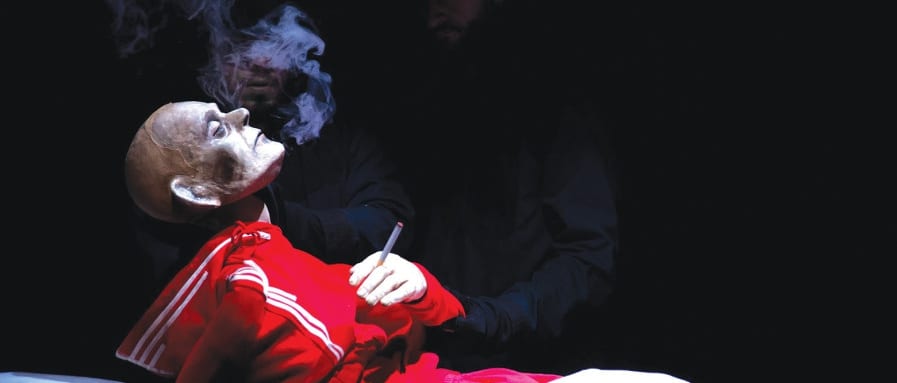There is no scene in Ashes when the tension breaks. Every part of this show is fraught with it, akin to the eerie silence before the killer in a slasher flick jumps out. In one seemingly innocuous moment in the show, a man kisses his mother on his way out of their house – yet something still feels uneasy. And then one by one, the houses behind them begin to burn.
Ashes parallels the lives of two men: an arsonist who goes on a spree and a writer (Viktor Lukawski) who, having heard the story of the fires all his life, tries to put it into words thirty years later. They battle their own inner demons – pyromania and alcoholism, respectively – as they try to take control of their lives and themselves.
Now might be a good time to mention that most of the personae onstage are not people at all, but life-size puppets. The show is a product of the French-Norwegian company Plexus Polaire, and life-size puppets are its specialty. They do not speak. There is no dialogue, only a few whispered words here and there. As a result, it can be difficult to tell at times what exactly is happening onstage, but you’ll be nevertheless mesmerized as you watch. Simple as it is, Ashes is a visually stunning production.
The puppeteers – Lukawski, Aitor Sanz Juanes, and Laetitia Labre – maneuver the scenes with remarkable ease. A scene in which the puppeteers float beer glasses around the writer’s head is as entertaining as it is melancholy. When they later do the same with gasoline cans around the arsonist, the connection between them is made clear. Throughout the scenes, they move effortlessly in and out of the shadows. It’s almost hypnotic.
The standout puppet is a massive, formidable coyote, the manifestation of the writer’s “inner beast.” As it wrestles with the writer, it is made to move with striking grace and power. We only ever see its front half – it, too, always lurks in the shadows, only heightening the tense mood of the show.
Those looking for a light, fun show will only find twisted glimmers of one in Ashes as the writer clumsily spills beer on his computer, as the arsonist does a sort of post-blaze victory dance complete with a moonwalk and a split. Come to think of it, though, the show is “light” in a different sense of the word. The fires haunt the writer into his adulthood, so much that he must write about them as a way to cope. The coyote’s eyes glow yellow against the dark stage. A fire is shown burning within the arsonist while houses burn around him. It’s a show that illuminates, if you will, the inner darkness of humans. And it might spark an interest in puppet theatre, too.

